Topics
Reproduction in Lower and Higher Plants
- Reproduction
- Mode of Reproduction in Plant
- Asexual Reproduction in Plant
- Vegetative Reproduction
- Natural Vegetative Reproduction
- Artificial Vegetative Reproduction
- Sexual Reproduction in Flowering Plants
- Pre-fertilization in Plant: Structure and Events
- Pre-fertilization in Plant: Stamen (Male Reproductive Unit)
- Pre-fertilization in Plant: Microsporangium
- Structure of Microspore Or Pollen Grain
- Pre-fertilization in Plant: Pistil (Female Reproductive Unit)
- Pre-fertilization in Plant: Megasporangium
- Pre-fertilization in Plant: Formation of Embryo Sac
- Pollination
- Self Pollination (Autogamy)
- Cross Pollination
- Agents of Pollination
- Outbreeding Devices
- Pollen Pistil Interaction
- Fertilization Process
- Post Fertilisation in Plant: Structures and Events
- Development of Endosperm
- Post Fertilization in Plant: Development of Embryo (Embryogeny)
- Formation of Seed and Fruit
- Apomixis
- Parthenocarpy
- Polyembryony
- Kinds of Pollination
Reproduction in Lower and Higher Animals
- Reproduction
- Mode of Reproduction in Animal
- Asexual Reproduction in Animal
- Sexual Reproduction in Animals
- Human Reproduction
- The Male Reproductive System
- The Female Reproductive System
- Menstrual Cycle (Ovarian Cycle)
- Gametogenesis
- Fertilization in Human
- Embryonic Development in Human
- Implantation in Human
- Pregnancy in Humans
- Placenta (Growth) in Human
- Parturition (Birth) in Human
- Lactation in Human
- Reproductive Health
- Population Stabilisation and Birth Control
- Medical Termination of Pregnancy (MTP)
- Sexually Transmitted Diseases (STD)
- Infertility
- Gastrulation in humans
Inheritance and Variation
- Heredity or Inheritance
- Gregor Johann Mendel – Father of Genetics
- Genes and Genetic
- Mendelian Inheritance - Mendel’s Law of Heredity
- Back Cross and Test Cross
- Deviations from Mendel’s Findings
- Chromosomal Theory of Inheritance
- Chromosomes - The Carriers of Heredity
- Linkage and Crossing Over
- Autosomal Inheritance
- Sex Linked Inheritance
- Sex Determination
- Genetic Disorders
Molecular Basis of Inheritance
- Deoxyribonucleic Acid (DNA) and Its Structure
- The Genetic Material is a DNA
- Packaging of DNA Helix
- DNA Replication
- Protein Synthesis
- Regulation of Gene Expression
- Operon Concept
- Genomics
- Human Genome Project
- DNA Fingerprinting Technique
- Genetic Code
Origin and Evolution of Life
- Origin and Evolution of Universe and Earth
- Theories of Origin of Life
- Chemical Evolution of Life (Self-assembly Theory of the Origin of Life)
- Darwinism
- Mutation Theory
- Modern Synthetic Theory of Evolution
- Organic Evolution
- Hardy Weinberg’s Principle
- Adaptive Radiation
- Evidences for Biological Evolution
- Speciation
- Geological Time Scale
- Human Evolution
- Theories of Biological Evolution
Plant Water Relation
- Plant Water Relation
- Properties of Water
- Water absorbing organ
- Water Available to Roots for Absorption
- Means of Transport in Plants
- Concept of Imbibition
- Simple Diffusion
- Concept of Osmosis
- Osmotic Pressure
- Facilitated Diffusion
- Turgidity and Flaccidity (Plasmolysis)
- Active Transport
- Passive Transport
- Water Potential (ψ)
- Path of Water Across the Root
- Translocation of Water (Ascent of Sap)
- Transport of Mineral Ions
- Transport of Food
- Transpiration
- Types of Transpiration
- Structure of Stomatal Apparatus
- Significance of Transpiration
Plant Growth and Mineral Nutrition
- Plant Growth
- Phases of Plant Growth
- Conditions Necessary for Plant Growth
- Plant Growth Rate
- Plant Growth Curve
- Differentiation, De-differentiation, Re- Differentiation
- Plant Development
- Plant Plasticity
- Plant Hormones
- Types of Plant Hormones: Auxins
- Types of Plant Hormones: Gibberellins
- Types of Plant Hormones: Cytokinins
- Types of Plant Hormones: Ethylene
- Types of Plant Hormones: Abscisic Acid (ABA)
- Photoperiodism
- Vernalization (Yarovization)
- Plant Mineral Nutrition
- Nitrogen Cycle
Respiration and Circulation
- Respiration
- Organs of Respiratory Exchange
- Human Respiratory System
- Mechanism of respiration-Breathing
- Regulation of Breathing / Respiration
- Modified Respiratory Movements
- Disorders of Respiratory System
- Transportation in Living Organisms
- Circulation in Animals
- Types of Closed Circulation
- Blood Circulatory System in Human
- Composition of Blood: Plasma (The Liquid Portion of Blood)
- Composition of Blood: Red Blood Cells (Erythrocytes)
- Composition of Blood: White Blood Cells (Leukocytes)
- Composition of Blood: Blood Platelets (Thrombocytes)
- Function of Platelets - Clotting of Blood (Coagulation)
- Human Heart
- Working mechanism of human heart
- Blood Vessels
- Blood Pressure (B.P.)
- Electrocardiogram (ECG)
- Lymph and Lymphatic System
- Mechanism of respiration - Internal respiration
- Mechanism of respiration - External respiration
- Mechanism of respiration - Cellular respiration
Control and Co-ordination
- Control and Co-ordination
- Nervous System in Hydra
- Nervous System in Planaria (Flatworm)
- Neural Tissue
- Neuron (Or Nerve Cell) and Its Types
- Neuroglial Cells (Or Glial Cells)
- Human Nervous System
- Central Nervous System (CNS)
- The Human Brain - Forebrain
- The Spinal Cord
- Peripheral Nervous System (PNS)
- Sensory Receptors
- Human Eye
- Human Ear
- Disorders of Nervous System
- Chemical Coordination
- Human Endocrine System
- The Hypothalamus
- Pituitary Gland or Hypophysis Gland
- The Pineal Gland
- Thyroid Gland
- Parathyroid Gland
- Thymus Gland
- Adrenal Gland (Suprarenal Gland)
- Pancreas (Islets of Langerhans)
- Reproductive Glands (Gonads)
- Synapse - Properties of nerve fibres
- Synapse - Types of synapse
- Transmission of nerve impulse
- Generation of nerve impulse
- Reflex Action
- Autonomic Nervous System (ANS)
- Diffuse Endocrine Glands
Human Health and Diseases
- Defence System in Our Body: Immune System
- Immunity
- Types of Immunity
- Vaccination and Immunization
- Structure of Antibody
- Disease
- Protozoan Diseases
- Helminthic Diseases
- Bacterial Diseases
- Viral Diseases
- Fungal Diseases
- Vector Borne Diseases
- Cancer
- Adolescence
- Addiction
- Drug Abuse
Enhancement of Food Production
- Improvement in Food Production
- Plant Breeding
- Tissue Culture
- Single Cell Protein (SCP)
- Biofortification
- Animal Husbandry (Livestock)
- Animal Breeding
- Dairy Farming
- Poultry Farming
- Apiculture (Bee Farming)
- Pisciculture (Fish Farming)
- Sericulture
- Lac Culture
- Microbes in Human Welfare
- Microbes in Industrial Production
- Microbes in Sewage Treatment
- Microbes in Energy Generation
- Microbes as Biocontrol Agents
- Microbes as Biofertilizers
Biotechnology
- Biotechnology
- Process and Principles of Biotechnology
- Methodology for rDNA Technology
- Commercial Applications of Biotechnology
- Bioethics
- Effects of Biotechnology on the Environment
- Biopatent and Biopiracy
- Transgenic Plants
- Transgenic animals
- Effects of Biotechnology on Human Health
- Tools and techniques for gene cloning/ rDNA technology
Organisms and Populations
- Organisms and the Environment Around
- Habitat
- Niche
- Structure and function of an Ecosystem
- Adaptations and Its Types
- Population
- Population Interactions
- Organisms and Populations
Ecosystems and Energy Flow
- Ecosystem
- Structure and function of an Ecosystem
- Concept of Energy Flow in an Ecosystem
- Classification of Animal
- Trophic Level
- Food Chain
- Food Web
- Ecological Pyramids
- Nutrient Cycles
- Ecological Succession
- Ecosystem Services
- Productivity
- Decomposition
- Phosphorus Cycle
- Carbon Cycle
Biodiversity, Conservation and Environmental Issues
- Biodiversity
- Levels of Biodiversity
- Patterns of Biodiversity
- Biodiversity Current Scenario
- Loss of Biodiversity
- Conservation of Wildlife
- Biological Diversity Act, 2002
- Environmental Issues
- Air Pollution and Its Causes
- Noise Pollution
- Water Pollution and Its Causes
- Green House Effect
- Preventive Measures of Green House Effect
- Global Warming
- Preventive Measures of Global Warming
- Ozone Layer Depletion
- Deforestation and Its Causes
- Mission Harit Maharashtra
- Conservation of Biodiversity
Excretion and Osmoregulation
- Modes of Excretion: Ammonotelism, Ureotelism, and Uricotelism
- Human Excretory System
- Function of the Kidney - “Production of Urine”
- Regulation of Kidney Function
- Common Disorders of the Urinary System
Human Reproduction
Artificial vegetative propagation
- Cutting
- Layering
- Grafting
- Tissue culture
Advantages of artificial vegetative reproduction
Disadvantages of artificial vegetative reproduction
Artificial vegetative reproduction:
- Artificial vegetative propagation is a type of plant reproduction that involves human intervention.
- Apart from the natural methods of vegetative reproduction, a number of methods are used in agriculture and horticulture to propagate plants from their parts. Such methods are said to be artificial propagation.
- Some of the artificial propagation methods have been used by man for a long time and are called conventional methods. Nowadays, technology is being used for propagation to produce a large number of plants in a short period of time. Such methods are said to be modern methods.
Modern Method:
Professor F.C. Steward (1932) of Cornell University showed that the mature phloem parenchyma cells removed from the carrot were placed in a suitable medium under controlled conditions, could be stimulated to start dividing again to produce a new carrot plant. These cells were described as totipotent. The genetic ability of a plant cell to produce the entire plant under suitable conditions is said to be totipotency. This characteristic feature of a cell is utilized in horticulture, forestry, and industries to propagate plants. The growth of plant tissue in a special culture medium under suitable controlled conditions is known as tissue culture.
 |
- Micropropagation: The regeneration of a whole plant from a single cell, tissue, or small pieces of vegetative structures through tissue culture is called micropropagation. This is one of the modern methods used to propagate plants.
Advantages of modern methods:
- Plants with desired characteristics can be multiplied rapidly in a short duration.
- Plants produced are genetically identical.
- Tissue culture can be carried out in any season to produce plants.
- Plants which do not produce viable seeds and seeds that are difficult to germinate can be propagated by tissue culture.
- Rare and endangered plants can be propagated.
- Disease-free plants can be produced by meristem culture.
- Cells can be genetically modified and transformed using tissue culture.
Disadvantages of modern methods:
- It is labour intensive and requires skilled workers.
- Sterile condition must be maintained which adds to the cost.
- Since the clones are genetically identical, the entire crop is susceptible to new diseases or changes in environmental conditions that will wipe out the species.
- Sometimes, callus undergoes genetic changes which are undesirable for commercial use.
Conventional methods:
The common methods of conventional propagation are cutting, grafting, and layering.
- Cutting: It is the method of producing a new plant by cutting the plant parts such as root, stem, and leaf from the parent plant. The cut part is placed in a suitable medium for growth. It produces roots and grows into a new plant. Before planting, cuttings are occasionally treated with hormones to stimulate root formation. Depending upon the part used it is called root cutting (Malus), stem cutting (Hibiscus, Bougainvillea, and Moringa), and leaf-cutting (Begonia, Bryophyllum). Stem cutting is widely used for propagation.
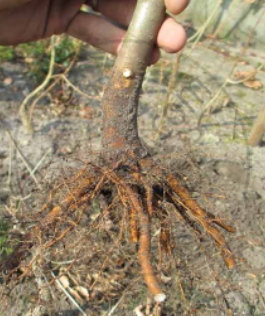
Root cutting - Malus
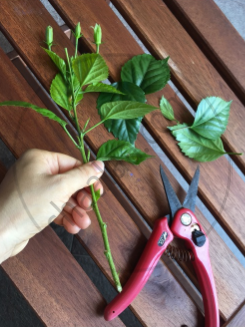
Stem cutting - Hibiscus
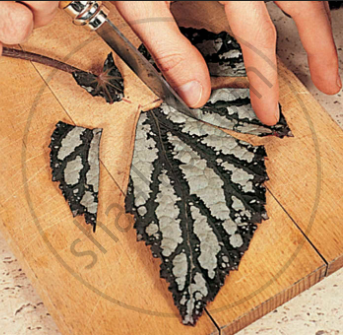
Leaf-cutting - Begonia
- Grafting: In grafting, parts of two different plants are joined so that they continue to grow as one plant. Of the two plants, the plant which is in contact with the soil is called stock, and the plant used for grafting is called the scion. Over time, the tissue systems of the cutting graft into or integrate with the tissue systems of the base plant. Examples are Citrus, Mango, and Apple.

Grafting
Types of grafting:
There are different types of grafting based on the method of uniting the scion and stock. They are bud grafting, approach grafting, tongue grafting, crown grafting, and wedge grafting.
i) Bud grafting: A T-shaped incision is made in the stock and the bark is lifted. The scion bud with little wood is placed in the incision beneath the bark and properly bandaged with tape.
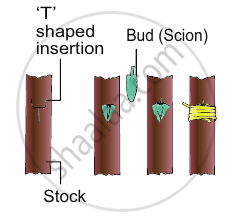
Bud grafting
ii) Approach grafting: In this method both the scion and stock remain rooted. The stock is grown in a pot and it is brought close to the scion. Both of them should have the same thickness. A small slice is cut from both and the cut surfaces are brought near and tied together and held by a tape. After 1-4 weeks the tip of the stock and base of the scion is cut off and detached and grown in a separate pot.
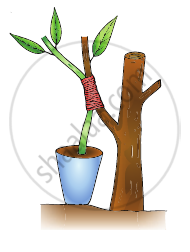
Approach grafting
iii) Tongue grafting: A scion and stock having the same thickness is cut obliquely and the scion is fit into the stock and bound with a tape.
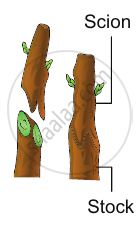
Tongue grafting
iv) Crown grafting: When the stock is large in size scions are cut into a wedge shape and are inserted on the slits or clefts of the stock and fixed in position using graft wax.

Crown grafting
v) Wedge grafting: In this method, a slit is made in the stock, or the bark is cut. A twig of the scion is inserted and tightly bound so that the cambium of the two is joined.

Wedge grafting
- Layering: In this method, the stem of a parent plant is allowed to develop roots while still intact. When the root develops, the rooted part is cut and planted to grow as a new plant. Examples: Ixora and Jasminum.
Types of layering:
Mound layering and Air layering are a few types of layering.
i) Mound layering: This method is applied for plants having flexible branches. The lower branch with leaves is bent to the ground and part of the stem is buried in the soil and the tip of the branch is exposed above the soil. After the roots emerge from the part of the stem buried in the soil, a cut is made in the parent plant so that the buried part grows into a new plant.
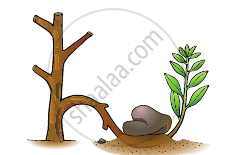
Mound layering
ii) Air layering: In this method the stem is girdled at nodal region and hormones are applied to this region which promotes rooting. This portion is covered with damp or moist soil using a polythene sheet. Roots emerge in these branches after 2-4 months. Such branches are removed from the parent plant and grown in a separate pot or ground -
Suckering: Suckering is the process through which suckers adhere to a parent plant and form a dense, compact mat. Excess suckers are trimmed because too many can result in reduced crop size. Mature suckers are separated from the parent plant and transplanted to a new location where they produce new plants. Suckering serves two purposes: it grows new shoots and removes nutrient-sucking buds that prevent the main plant from expanding.
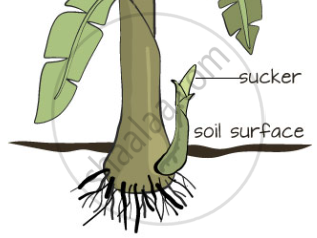
Suckering - Banana tree
Advantages of conventional methods:
- The plants produced are genetically uniform.
- Many plants can be produced quickly by this method.
- Some plants produce little or no seeds; in others, the seeds produced do not germinate. In such cases, plants can be produced in a short period by this method.
- Some plants can be propagated more economically by vegetative propagation. Example: Solanum tuberosum.
- Two different plants with desirable characters such as disease resistance and high yield can be grafted and grown as a new plant with the same desirable characters.
Disadvantages of conventional methods:
- Use of virus-infected plants as parents produces viral-infected new plants.
- Vegetative structures used for propagation are bulky and so they are difficult to handle and store.
